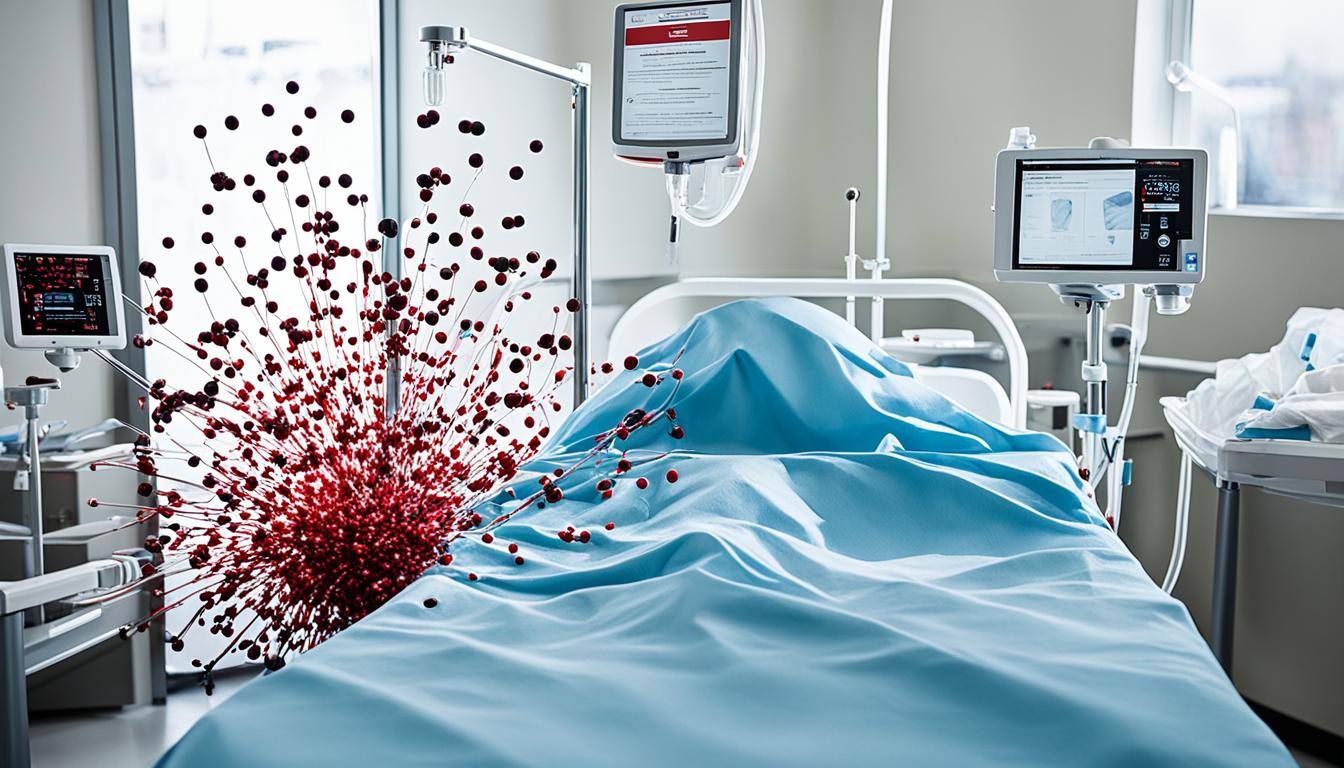Methicillin-resistant Staphylococcus aureus (MRSA) is a serious bacteria type. It causes infections in the skin, soft tissues, the bloodstream, and the lungs. What makes MRSA dangerous is its resistance to many antibiotics.
People with MRSA may see different signs, depending on the infection. Yet, they might notice redness, swelling, warmth, and pain where they have the infection. MRSA can spread in the community or hospitals. Being close to an infected person, having a weak immune system, and taking antibiotics often makes one more at risk.
Doctors confirm MRSA with a test from the infected area. They use strong antibiotics that work against MRSA like vancomycin. Sometimes, doctors think about stem cell therapy as a way to treat MRSA.
Key Takeaways:
- MRSA is a type of bacteria that is resistant to many common antibiotics.
- Symptoms of MRSA infection include redness, swelling, warmth, and pain at the site of infection.
- MRSA infections can be acquired in the community or in healthcare settings.
- Diagnosis of MRSA infection involves laboratory testing of a sample from the infected area.
- Treatment options for MRSA infection may include antibiotics effective against MRSA and stem cell therapy.
MRSA Outbreaks and Prevention Measures
MRSA outbreaks can happen in many places. This includes hospitals, nursing homes, and schools. Stopping the bacteria from spreading is hard but important. To keep MRSA in check, we must use many prevention methods.
Practice Good Hygiene
Good hygiene is key to stopping MRSA. Wash hands often with soap for at least 20 seconds. Do this before and after touching things, using the bathroom, or eating. Clean skin is a strong defense against MRSA.
Keep Wounds Clean and Covered
Take care of wounds well to prevent MRSA. Clean cuts with soap and water and put on an antiseptic. Then, cover the wound with a bandage. Quick care keeps MRSA out.
Avoid Sharing Personal Items
Sharing items like towels and razors can spread MRSA. Tell people not to share and to use their own things. This cuts down on the risk of spreading the bacteria.
Infection Control Measures in Healthcare Settings
Healthcare places need strict control to stop MRSA. This means cleaning and disinfecting often. Also, use special precautions with infected patients. These steps lower MRSA’s chance to spread.
Strict Hand Hygiene Protocols
Keeping hands clean is a big part of fighting MRSA. Workers, patients, and visitors must wash often. If there’s no soap, use sanitizer. Always clean hands before and after seeing patients or touching things that might have MRSA.
Screening and Surveillance Programs
Testing and watching for MRSA helps catch it early. Screen people who might bring MRSA to others, like healthcare workers. This stops them from spreading the bacteria unknowingly.
Education and Awareness Campaigns
Teaching people about MRSA is key to stopping it. Educating healthcare workers, patients, and the public helps. It raises awareness on how to stop MRSA and motivates people to prevent infections.
MRSA Diagnosis and Antibiotic-Resistant Strains
Diagnosing MRSA starts with taking a sample from the infection site, like a wound. This sample is sent to a lab for tests. The lab checks if the bacteria is MRSA. It also sees which antibiotics can fight it.
MRSA doesn’t respond to typical antibiotics like penicillin. This is because of a special protein that the mecA gene makes. Doctors then use different antibiotics like vancomycin, linezolid, and daptomycin to fight MRSA.
Unfortunately, some MRSA types are now resistant to these stronger antibiotics. This issue makes MRSA especially hard to treat. It shows why scientists need to keep looking for new treatments.
Comparison of Antibiotics for MRSA Infections
| Antibiotic | Usage | Effectiveness | Common Side Effects |
|---|---|---|---|
| Vancomycin | Administered intravenously | Highly effective against MRSA | Nausea, vomiting, kidney damage |
| Linezolid | Administered orally or intravenously | Effective against MRSA | Headache, diarrhea, low platelet count |
| Daptomycin | Administered intravenously | Effective against MRSA | Muscle pain, fever, gastrointestinal symptoms |
Doctors choose MRSA antibiotics based on many things. This includes how serious the infection is and the patient’s health. It’s vital for doctors to know the best treatment steps. This ensures patients get the right care.
Image: The image above illustrates the concept of MRSA diagnosis and the challenges posed by antibiotic-resistant strains of MRSA.
Stem Cell Therapy for MRSA Infection
Stem cell therapy is a new area in medical research with great potential to combat MRSA. Stem cells can turn into different cell types. This ability is crucial for repairing and renewing tissues.
In the context of MRSA, stem cell therapy aims to heal infected wounds. It also helps in building back damaged tissues.
Studies show that stem cells can boost the immune system and fight off germs. They might be helpful in treating MRSA, a type of infection that can resist many antibiotics. Yet, more research is needed to understand how well stem cell therapy fights MRSA.
There are ongoing trials to check how safe and effective stem cell therapy is against MRSA. The medical field is eagerly looking into this new way of treating MRSA. Stem cell therapy could be a key in helping MRSA patients get better.

